This is the beginning of the second part of my Christmas holidays spent in Osaka, second biggest city in Japan. The first part can be reached here.
Thus Gilles Rey-Mermet and I arrive to Osaka on January 4th after one week of traveling around the southern island of Japan, Kyusyu. The first thing we do is to call for our apartment at a phone number specified in the gLonely Planeth. It is called Shin-Osaka and is supposed to be at only 4 minutes by walk from the Shin-Osaka station and cost only 10050 yens (125$)/week. Well, it is a bit too good to be true. Hence, it is with suspicion that I take the phone. The grave voice of man answers and I ask for information (we had already reserved). He passes the phone to a woman who speaks English. She is asking for 60000 yens (700$) immediately and a photocopy of our passport. A little aback, I tell her that we do not that much money right now. Because it is late in the afternoon, the banks are closed (in Japan, the automatic machines close as well, stupid isnft it?!). We set for a deal of 30000 yens but I am still curious and want to take a look at the apartment. She tells us that she will come pick us at the station in 10 minutes.
Wait.
After 30 minutes, nobody comes. Hum! It is the last day of holidays and all the streets are jammed. It takes them 45 minutes by car to get all around the station to find us. The man looks like an old-style yakusa (Mafioso) and the car is quite old as well... We get in and finally, arrive to the apartment. It is not really five stars but it is O.K. The extra money that she asked for is a 20000 yens deposit for each of us, just in case that we break something. We pay 30000 yens tonight and will pay the rest tomorrow once the bank will open. There are 12 beds (six juxtaposed beds) but there is only 4 people living in right now. An Australian, a Chinese, a Japanese and, yes, a Canadian from Yukon! Wow! There are all more or less learning Japanese except the Japanese who wants to learn English by speaking with the other guys. This apartment is a hell of a deal for travelers and short-stay living people.
DAY 2: Craziness in OsakaToday, we want to discover Osaka. We walk from North to South (i.e. from Shin-Osaka to Namba). This is a huge city and it takes us the whole day to walk it up. Just the bridge is so long and crowded that the exhaust gases intoxicate us. Puah! I told Gilles that we are better off taking the subway for that part of the city next time. Once in downtown nearby Umeda station, it becomes more noisy and crowded. Ouf! Again, girl teenagers are queens for the day-after-day consumption of clothes, accessories, etc. as they wander around in department stores. Skyscrapers are very modern and architecturally very innovative. One of them has even a gGrande-Roueh at its top! We drop by a huge concrete temple where suddenly there is absence of noise and the peaceful smell of incense sticks left over by some passing people. We sit down and get literally hypnotized by the ambiance. It seems that all the outside craziness could not baffle the thick walls of this temple. Drained by the speed of urban life, this rest is the ultimate quietude. Back in the real world, we find a good sushi restaurant where the pieces of fish are so big that we need two mouthfuls to eat it all. The main arcade that crosses the city from North to South must be some 4 kilometers long. Its center is cut by the Dotomburi street which we had fun calling Domburi street (the name of a Japanese rice meal). The canal, which passes along this street, is beautifully illuminated. As a first impression of the city, we are very impressed. |
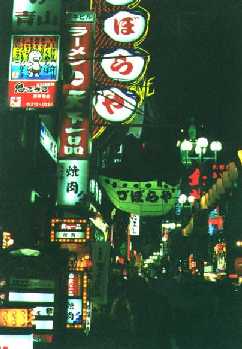
|
Today, we visit from East to West starting with the well-known Osaka castle. According to the gLonely Planeth, the castlefs exterior retains a certain grandeur but the interior looks like a barn with lifts. A barn?! Nevertheless curious, we want to take a look anyway. The original castle, completed in 1583, was a display of power on the part of Toyotomi Hideyoshi. However, it was destroyed just 32 years later in 1615 by the armies of Tokugawa Ieyasu. Further calamity would occur and it finally falls to the forces of the Meiji Restoration in 1868. The interior of todayfs castle houses a museum of Toyotomi Hideyoshi. Of my opinion, it is quite good and certainly not comparable to a barn.

|
Everybody has visited an aquarium once in his life and we are no exception. So at first thought, we did not see the point to go to another aquarium to see yet other colorful fishes from somewhere in Australia... But this one was finally truly worth the visit. Its theme being the Ring of Fire that surrounds the Pacific Ocean, the arrangement of the aquariums inside the building is very original. As a continuous circular descent from the top, we start from the Gulf of Panama, and go through the Coast of Chile, Antarctica, Aleutian islands, Tasman Sea, Great Barrier Reef, Japan forest, kelp forest, Cook Strait, Arctic and Californian ecosystems. All around the main water tank which represents the middle of the Pacific Ocean. The elegantly swimming gigantic whale shark in the latter is majestic and we can recognize every fish that Japanese are fond of...on sushi of course! This largest tank contains 5,400 tons of water with a depth of 9 meters. The transparent glass is something like 30 centimeters thick! The Japan deeps (200-400 meters) where no sunlight ever reaches features giant spider crabs, the largest crab in the world (1 meter in diameter, with the arms expanded). That is a lot of crabmeat! |
After the visit to the Osaka Aquarium, we are bound for another largest thing in the world: the Giant Wheel! At night, we enjoy a panoramic view of Osaka Bay, ranging from the Akashi Bridge (which is also the longest suspended bridge) and the entirely illuminated metropolis of Osaka. It takes more than 15 minutes to make one revolution!
DAY 4: Welcome aboard, Mr. SpockOne of the landmarks of Osaka is the Shin-Umeda building. It is two skyscrapers connected at the top by an extensive (and certainly expensive) platform. A hole was made in the middle of the platform so we can see through. It is a very artistic and modern architecture. Hostesses ridiculously dressed almost like Star Trek members (but that was not intended to I guess?!) guide us to the top where the wind is strong and chilly. Yet another panoramic view but right in the middle of the downtown. The clear sky enables us to look as far as Kobe, which is on the other side of the Osaka Bay. I was lured in seeing a Japanese theatrical play. Gilles had seen two Noh representations already and I was kind of jealous since I never went to any one yet. Therefore, the Bunraku, a local particularity of Osaka, is the perfect choice for this afternoon. As soon as we entered the national Bunraku Theater, two women offered us a free ticket! Wow! Even more cool is that the place is on the front row and right in the middle. Gilles buys the next ticket just beside, which costs 6000 yens that we split in two parts. |

|
|
The Bunraku Puppet Theatre, which is probably the most refined form of puppetry in the world, is a combination of three skills each of which requires many years of training to master: puppet manipulation, joruri recitation and shamisen music. The dolls of the Bunraku Puppet Show are about half life-size. Their eyes move, their eyebrows rise in surprise, their mouths open and shut, and their hands and arms gesture gracefully and realistically. Three manipulators who work in perfect unison operate each of the principal dolls. The manipulators carry the dolls on the stage and are visible throughout the play. The chief manipulator holds the puppet from the back with his left hand by a special grip in the figurefs chest and directs the puppetfs right arm with his right hand. The second operator moves the left hand and the third, the legs. As a female doll has no legs as a rule (?!), the third operator moves its skirt in such a way as to create an illusion of moving legs. |
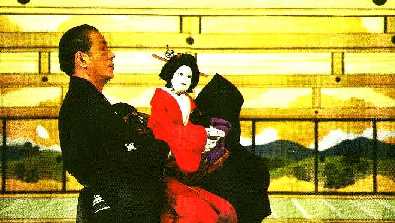
|
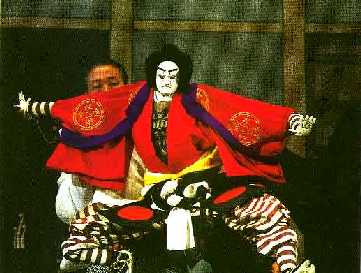
|
The joruri reciter, who tells the story, which the puppets act and who chants, shouts, whisper or sobs the dialogue for all characters appearing in the play. He sits with his shamisen accompanist, each resplendent in the traditional kimono dress, in the full view on an elevated place at the right of the stage. The shamisen is no less important an element in the puppet show. He provides not only the musical accompaniment to the joruri recitation but also an indication, where appropriate, of the sound of rain or wind or other effects to heighten the atmosphere of the scene. We assisted to three representations, which will be long to explain, as they are quite complicated as classical theater should be. The whole show lasted four hours and a half! This is longer than a hockey game, over-time included! The third story was the simplest and most enjoyable. The story is about two samurai leaders who are forcing a courtesan, Akiyo, intimate of a spy to reveal where her lover is. She insists on denying any knowledge of him, so she is about to be tortured when one samurai interferes, saying that she is too tender to be roughly treated. He orders Akiyo to play three kinds of musical instruments, koto, shamisen and kokyu (three types of traditional Japanese guitars). He reasons that if so sensitive a musician as Akoya is reputed to be can play the instruments without fault, her conscience must be untroubled and her plea of ignorance justified. Akoya, knowing that her loverfs safety depends on her composure, steels herself to complete control and plays superbly. So splendidly does she perform that the samurais are convinced that Akoya is not concealing information and permits her to go. |
|
This story is amusing and depicts the samuraifs way of thinking very easily. Purity is revealed only through action. What is also funny is that Akiyo is only a doll... The beauty is that the three manipulators must be perfectly synchronized with the corresponding instrument accompanist. It is like seeing two shows in one, the Bunraku and the musical performance. Finally, Bunraku masters all come from the same very few families hence we could recognize the faces of the same family and the strict hierarchy (the older playing more important roles than younger). Enchanted by our Bunraku experience, we went on the Dotomburi Street to eat a very special meal made of fugu, an extremely poisonous fish if not cut and cooked correctly. Winter is the fugu season and eaten raw, one small plate costs 3000 yens (about 40$). Is it the pleasure to eat something so dangerous or the extremely refined taste that makes it so expensive? Certainly both. It is said that one way to be safe is to leave the guest eat it first and wait five minutes to be certain. If no complexion occurs, the fugu is fresh and not poisonous. Ouf! |
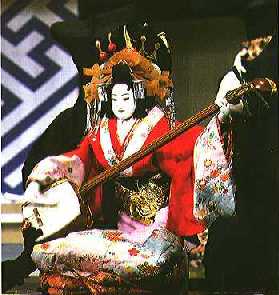
|
Today, we visit Kobe, which is at only 30 minutes by train from Shin-Umeda station. Most people know this city because of the earthquake that occurred on January 17th, in 1994. The effects of the earthquake are no more present at all except for a small dock left untouched for visitors. We walk around the business area and Chinatown. It is very cold and hot manjyus (ball of pork meat surrounded by bread) sold on the Chinatown streets are delicious. The trip is coming to an end... one more full day.
DAY 6: Pretty girl-priestsThe festival of Toka Ebisu, the Chinese god for merchants is celebrated from the 9th to the 11th of January every year. It is a major celebration since huge crowd of more than a million of people flock to the Imamiya Ebisu Shrine to receive bamboo branches hung with auspicious tokens. This is the perfect festival to finish a great trip! At first, we have some problems finding the street where the parade will come to pass. A nearby hippodrome where old gamblers gather misguides us. Asking many policemen, we find the avenue where fast food vending kiosks are preparing to receive the masses. In few minutes, the head of the parade is there and festival floats hauled by young people carry beautiful women, one of which is Miss. Osaka 1999! Drinking sake passed around by enchanted merchants, saluting the attractive girls and Gilles taking tons of pictures. We just could not believe the luck we were having! But still, that was not the ultimate experience to come today. |
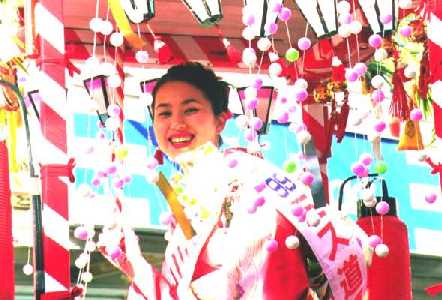
|
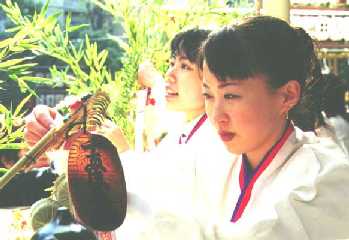
|
Once the parade arrived to the famous Shrine, the crowd had expanded drastically. It was getting difficult to move around. Everybody was crazy going to the main stage to receive the glorious branches of bamboo. After debating a while, I could finally grab two for each of us. But these branches have no meaning in themselves. They must be attached by some luck-driven token, which are sold by the most pretty Japanese girls I have never seen. It is said that these girl-priests are 50 selected among 6000 entries for their aesthetic smile, attractive eyes and pure charisma. Ouf! These tokens are expensive, mostly 1500 yens each. Some people, probably merchants, were carrying a few dozens on their branches! |
We remark a foreigner who is talking lengthily to one of the girl-priest. Grabbing him, we find out that he comes from Italy and his name is Armano. He is salesman for an agricultural company in Switzerland and Germany. Speaking French, Gilles had found someone to talk about his hometown! Armano, like all Italians I guess, is very loquacious particularly about girlsf matters... He is in Japan to visit a Japanese girl who traveled in Italy before. It turns out that she is girl-priest today and he was looking for her. The amusing thing is that she is 21 and he is 36! He will find her of course but she is busy. Customers are flooding the Shrine and we must just say hello. Later, we will have more time to chant gKawaiih (Cute!) in cheer. The day is spent wandering around talking about our little lives. We make Armano eat sushi and drink sake for his first time. The night is beautiful with all the streets illuminated and the festival ambiance. It is unforgettable!
We receive our deposit for the apartment and go back home by Shinkansen. On our way, the train must slow down because of a snowstorm in the mountains. However, as soon as we arrive to Nagoya, all the snow has disappeared fortunately. Happy to be home, I nevertheless still find my room very small...
